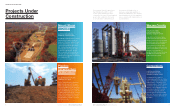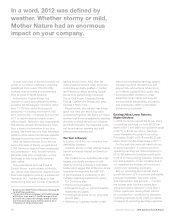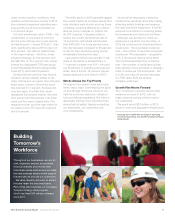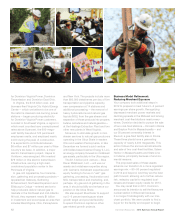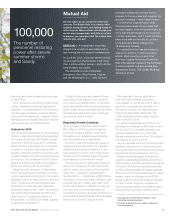Dominion Power 2012 Annual Report Download - page 15
Download and view the complete annual report
Please find page 15 of the 2012 Dominion Power annual report below. You can navigate through the pages in the report by either clicking on the pages listed below, or by using the keyword search tool below to find specific information within the annual report.
2012 Summary Annual Report Dominion Resources 17
words, state-of-the-art nuclear reactors
and cleaner coal-fired units must also
be part of our energy future.
Energy is critical to all aspects of our
economy and society. We would welcome
a national policy discussion, starting with
generation fuel diversity, with open arms.
Thank You
In 2012, we fell short of our earnings
guidance, and our total shareholder return
grew less than it did during the prior year.
However strong the headwinds — and
storms — your company improved its
safety performance, moved steadily
ahead on a capital-intensive infrastruc-
ture growth program and weathered the
storm. It is a testament to 15,500 talented
and dedicated Dominion employees, and
your faith in our company’s policies and
direction. Together, we can build for a
brighter tomorrow.
Thank you for investing your hard-earned
money in Dominion.
Sincerely,
Thomas F. Farrell II
Chairman, President
and Chief Executive Officer
At the same time, Dominion Virginia
Power was selected by the DOE to begin
award negotiations for initial engineering,
design and permitting for an offshore
wind turbine demonstration facility. Two
Alstom 6-megawatt turbines would be
placed on innovative foundations 24 miles
off the Virginia coast. This marks a positive
first step in the development of large-
scale offshore wind energy in the U.S.
We are proud to be among the nation’s
pioneers in the field.
A Necessary Energy Debate
At the beginning of this letter, I men-
tioned that full-fledged discussions and
debates on energy issues were largely
absent in the 2012 campaign. Voters
heard soundbites as the candidates
focused on other important matters.
In my 17 years in the industry, time and
again I have witnessed how the media’s
and public’s attention shifts to energy
only during extreme service disruptions
such as after Sandy or when energy bills
go up. Consider this: Since President
Barack Obama was first elected, electric
bills have risen only slightly and utility
gas bills have dropped by nearly a third.
At the same time, consumers have
experienced double-digit percentage
increases in such essential services
and products as college tuition and fees
and prescription drugs, issues that
were discussed frequently on the
campaign trail.
Our industry, including our regulators
and other watchdogs, needs to unite
to lead the debate and get out in front
before the next major disruption or rate
spike occurs. If the goal is to maintain
reliable electric service and stable rates,
a national debate on energy is required.
Among other items, energy policies
must encourage fuel diversity in electric
generation. For too long the government,
through policies and regulations, has
picked winners and losers. Said another
way, policymakers have chosen which
fuel sources are best for the country,
sometimes ignoring market signals and
other economic factors. The current
winners include renewables and natural
gas, to the detriment of nuclear and coal.
In the mid-Atlantic, Northeast and
Midwest alone, retirements of uneco-
nomic or environmentally challenged
coal units serving more than 5 million
customers are expected to take place by
2016. And the nation’s 104 nuclear reac-
tors likely will be decommissioned within
the next 25 to 30 years, with very few on
the drawing board to be replaced. If the
nation were to replace these generating
sources under current rules with only
gas and renewables, that is the type of
strategy that will lead to energy insecu-
rity and, for American families, less stable
and potentially debilitating rates.
For the sake of grid reliability and price
stability, an all-of-the-above approach
must truly be all of the above. In other
However strong the headwinds,
your company improved its
safety performance, moved steadily
ahead on a capital-intensive
infrastructure growth program
and weathered the storm.


